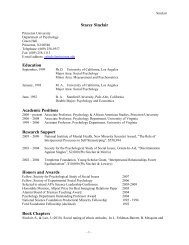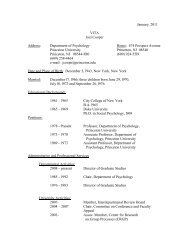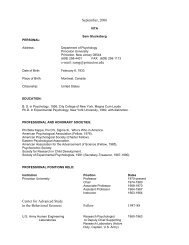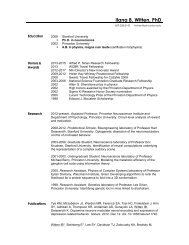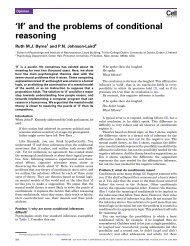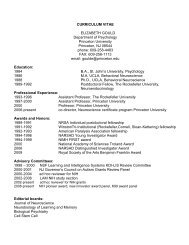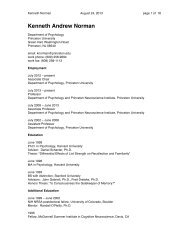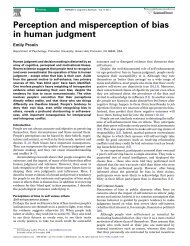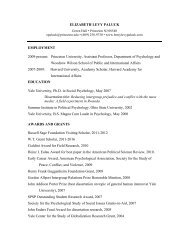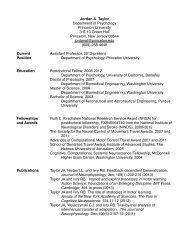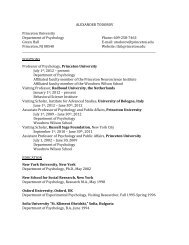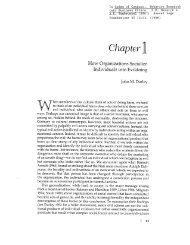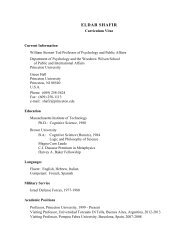Yael Niv - Department of Psychology - Princeton University
Yael Niv - Department of Psychology - Princeton University
Yael Niv - Department of Psychology - Princeton University
You also want an ePaper? Increase the reach of your titles
YUMPU automatically turns print PDFs into web optimized ePapers that Google loves.
“How we (might) use reinforcement learning to decide how fast to move” in: “How fast?”Trajectory control, movement energy, and the basal ganglia, Symposium in the Annual Meeting <strong>of</strong>the Society for the Neural Control <strong>of</strong> Movement, Naples, Florida (May 2008)“How animals (might) use RL to decide how fast to work”, Fast Reinforcement Learningmeeting, Barbados (April 2008)“Tonic dopamine, motivation and the optimal choice <strong>of</strong> response rates”, Neural circuits anddecision making in rodents, Invited talk, Janelia Farm, (April 2008)Neurotheory Seminar Series, Columbia <strong>University</strong> (February 2008)2007 “Opportunity costs and response rates: How dopamine helps us choose how hard to work”,invited seminar, BMS seminar series, Caltech (November 2007)“Reinforcement learning and free operant behavior: from motivation to optimal selection <strong>of</strong>response vigor”, invited seminar, H<strong>of</strong>stra <strong>University</strong>, NY (October 2007)“Hierarchical reinforcement learning: What is it, and why should we care?”, ChampalimaudNeuroscience Workshop: Neural bases <strong>of</strong> reward and decision making 2.0, Invited talk,Lisbon, Portugal (September 2007)“Contrasting risk-sensitive and risk-neutral learning in an fMRI study <strong>of</strong> instrumental choice”,Neur<strong>of</strong>inance symposium on The neural bases for human decision making underuncertainty, Invited talk, <strong>University</strong> <strong>of</strong> Zurich (July 2007)“Computationally linking dopamine and vigor: motivation bridges the gap”,Schoenbaum/O’Donnell labs’ Systems journal club, invited seminar, <strong>University</strong> <strong>of</strong> Maryland(May 2007)2006 “Cost, benefit, tonic, phasic: What does response vigor tell us about dopamine andmotivation?”, invited seminar, Neuroeconomics seminar series, NYU (Nov 2006)“Cost, benefit, tonic, phasic: What does response vigor tell us about dopamine andmotivation?”, Workshop on Reward and decision making in cortico-basal ganglianetworks, invited talk, Lake Arrowhead, California (June 2006)“Choosing how hard to work: A normative account <strong>of</strong> response vigor, motivation and tonicdopamine”, <strong>Psychology</strong> department, invited seminar, Cambridge <strong>University</strong> (July 2006)“Dealing with change: Learned and immediate effects <strong>of</strong> changes in subjective reward utility,on behavior”, Symposium on Choice and the Brain, invited talk, California Institute <strong>of</strong>Technology (June 2006)Tsodyks Lab, invited seminar, Weizmann Institute (April 2006)“Dopamine and reward”, Course on Schizophrenia: A Systems Neuroscience Perspective,invited lecture, Weizmann Institute (April 2006)Rushworth Lab, invited seminar, Cambridge, UK (Jan 2006)2005 Montague Lab, invited seminar, Baylor College <strong>of</strong> Medicine (Nov 2005)“Deciding how hard to work: A normative account <strong>of</strong> response vigor, motivation and tonicdopamine”, invited talk, Computational Cognitive Neuroscience Conference (Nov 2005)Phelps Lab, invited seminar, NYU (Nov 2005)“Uncertainty based competition between multiple reinforcement learning systems in thebrain”, Interdisciplinary Center for Neural Computation Annual Retreat (Jan 2005)



